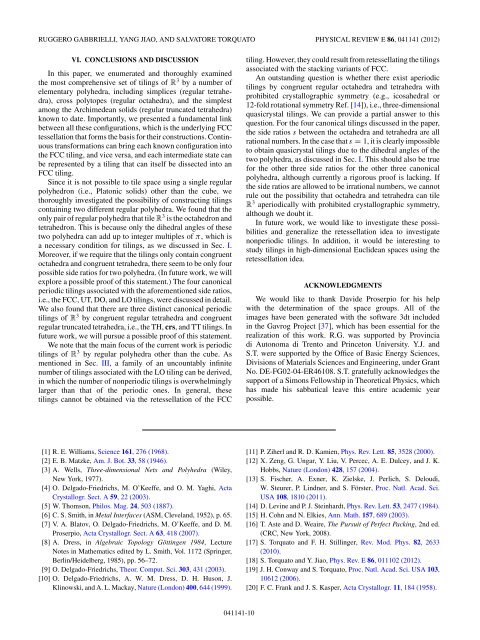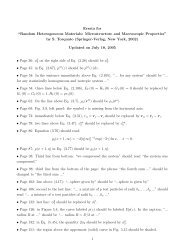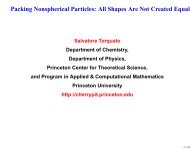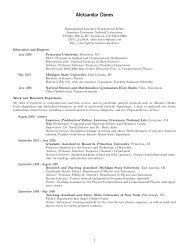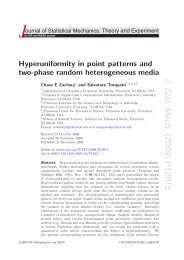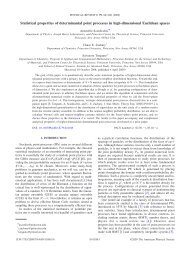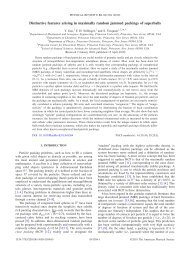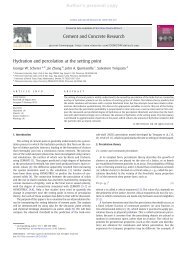Families of tessellations of space by elementary polyhedra via ...
Families of tessellations of space by elementary polyhedra via ...
Families of tessellations of space by elementary polyhedra via ...
Create successful ePaper yourself
Turn your PDF publications into a flip-book with our unique Google optimized e-Paper software.
RUGGERO GABBRIELLI, YANG JIAO, AND SALVATORE TORQUATO PHYSICAL REVIEW E 86, 041141 (2012)<br />
VI. CONCLUSIONS AND DISCUSSION<br />
In this paper, we enumerated and thoroughly examined<br />
the most comprehensive set <strong>of</strong> tilings <strong>of</strong> R3 <strong>by</strong> a number <strong>of</strong><br />
<strong>elementary</strong> <strong>polyhedra</strong>, including simplices (regular tetrahedra),<br />
cross polytopes (regular octahedra), and the simplest<br />
among the Archimedean solids (regular truncated tetrahedra)<br />
known to date. Importantly, we presented a fundamental link<br />
between all these configurations, which is the underlying FCC<br />
tessellation that forms the basis for their constructions. Continuous<br />
transformations can bring each known configuration into<br />
the FCC tiling, and vice versa, and each intermediate state can<br />
be represented <strong>by</strong> a tiling that can itself be dissected into an<br />
FCC tiling.<br />
Since it is not possible to tile <strong>space</strong> using a single regular<br />
polyhedron (i.e., Platonic solids) other than the cube, we<br />
thoroughly investigated the possibility <strong>of</strong> constructing tilings<br />
containing two different regular <strong>polyhedra</strong>. We found that the<br />
only pair <strong>of</strong> regular <strong>polyhedra</strong> that tile R3 is the octahedron and<br />
tetrahedron. This is because only the dihedral angles <strong>of</strong> these<br />
two <strong>polyhedra</strong> can add up to integer multiples <strong>of</strong> π, which is<br />
a necessary condition for tilings, as we discussed in Sec. I.<br />
Moreover, if we require that the tilings only contain congruent<br />
octahedra and congruent tetrahedra, there seem to be only four<br />
possible side ratios for two <strong>polyhedra</strong>. (In future work, we will<br />
explore a possible pro<strong>of</strong> <strong>of</strong> this statement.) The four canonical<br />
periodic tilings associated with the aforementioned side ratios,<br />
i.e., the FCC, UT, DO, and LO tilings, were discussed in detail.<br />
We also found that there are three distinct canonical periodic<br />
tilings <strong>of</strong> R3 <strong>by</strong> congruent regular tetrahedra and congruent<br />
regular truncated tetrahedra, i.e., the TH, crs, and TT tilings. In<br />
future work, we will pursue a possible pro<strong>of</strong> <strong>of</strong> this statement.<br />
We note that the main focus <strong>of</strong> the current work is periodic<br />
tilings <strong>of</strong> R3 <strong>by</strong> regular <strong>polyhedra</strong> other than the cube. As<br />
mentioned in Sec. III, a family <strong>of</strong> an uncountably infinite<br />
number <strong>of</strong> tilings associated with the LO tiling can be derived,<br />
in which the number <strong>of</strong> nonperiodic tilings is overwhelmingly<br />
larger than that <strong>of</strong> the periodic ones. In general, these<br />
tilings cannot be obtained <strong>via</strong> the retessellation <strong>of</strong> the FCC<br />
[1] R. E. Williams, Science 161, 276 (1968).<br />
[2] E. B. Matzke, Am. J. Bot. 33, 58 (1946).<br />
[3] A. Wells, Three-dimensional Nets and Polyhedra (Wiley,<br />
New York, 1977).<br />
[4] O. Delgado-Friedrichs, M. O’Keeffe, and O. M. Yaghi, Acta<br />
Crystallogr. Sect. A 59, 22 (2003).<br />
[5] W. Thomson, Philos. Mag. 24, 503 (1887).<br />
[6]C.S.Smith,inMetal Interfaces (ASM, Cleveland, 1952), p. 65.<br />
[7] V. A. Blatov, O. Delgado-Friedrichs, M. O’Keeffe, and D. M.<br />
Proserpio, Acta Crystallogr. Sect. A 63, 418 (2007).<br />
[8] A. Dress, in Algebraic Topology Göttingen 1984, Lecture<br />
Notes in Mathematics edited <strong>by</strong> L. Smith, Vol. 1172 (Springer,<br />
Berlin/Heidelberg, 1985), pp. 56–72.<br />
[9] O. Delgado-Friedrichs, Theor. Comput. Sci. 303, 431 (2003).<br />
[10] O. Delgado-Friedrichs, A. W. M. Dress, D. H. Huson, J.<br />
Klinowski, and A. L. Mackay, Nature (London) 400, 644 (1999).<br />
041141-10<br />
tiling. However, they could result from retessellating the tilings<br />
associated with the stacking variants <strong>of</strong> FCC.<br />
An outstanding question is whether there exist aperiodic<br />
tilings <strong>by</strong> congruent regular octahedra and tetrahedra with<br />
prohibited crystallographic symmetry (e.g., icosahedral or<br />
12-fold rotational symmetry Ref. [14]), i.e., three-dimensional<br />
quasicrystal tilings. We can provide a partial answer to this<br />
question. For the four canonical tilings discussed in the paper,<br />
the side ratios s between the octahedra and tetrahedra are all<br />
rational numbers. In the case that s = 1, it is clearly impossible<br />
to obtain quasicrystal tilings due to the dihedral angles <strong>of</strong> the<br />
two <strong>polyhedra</strong>, as discussed in Sec. I. This should also be true<br />
for the other three side ratios for the other three canonical<br />
<strong>polyhedra</strong>, although currently a rigorous pro<strong>of</strong> is lacking. If<br />
the side ratios are allowed to be irrational numbers, we cannot<br />
rule out the possibility that octahedra and tetrahedra can tile<br />
R 3 aperiodically with prohibited crystallographic symmetry,<br />
although we doubt it.<br />
In future work, we would like to investigate these possibilities<br />
and generalize the retessellation idea to investigate<br />
nonperiodic tilings. In addition, it would be interesting to<br />
study tilings in high-dimensional Euclidean <strong>space</strong>s using the<br />
retessellation idea.<br />
ACKNOWLEDGMENTS<br />
We would like to thank Davide Proserpio for his help<br />
with the determination <strong>of</strong> the <strong>space</strong> groups. All <strong>of</strong> the<br />
images have been generated with the s<strong>of</strong>tware 3dt included<br />
in the Gavrog Project [37], which has been essential for the<br />
realization <strong>of</strong> this work. R.G. was supported <strong>by</strong> Provincia<br />
di Autonoma di Trento and Princeton University. Y.J. and<br />
S.T. were supported <strong>by</strong> the Office <strong>of</strong> Basic Energy Sciences,<br />
Divisions <strong>of</strong> Materials Sciences and Engineering, under Grant<br />
No. DE-FG02-04-ER46108. S.T. gratefully acknowledges the<br />
support <strong>of</strong> a Simons Fellowship in Theoretical Physics, which<br />
has made his sabbatical leave this entire academic year<br />
possible.<br />
[11] P. Ziherl and R. D. Kamien, Phys.Rev.Lett.85, 3528 (2000).<br />
[12] X. Zeng, G. Ungar, Y. Liu, V. Percec, A. E. Dulcey, and J. K.<br />
Hobbs, Nature (London) 428, 157 (2004).<br />
[13] S. Fischer, A. Exner, K. Zielske, J. Perlich, S. Deloudi,<br />
W. Steurer, P. Lindner, and S. Förster, Proc. Natl. Acad. Sci.<br />
USA 108, 1810 (2011).<br />
[14] D. Levine and P. J. Steinhardt, Phys.Rev.Lett.53, 2477 (1984).<br />
[15] H. Cohn and N. Elkies, Ann. Math. 157, 689 (2003).<br />
[16] T. Aste and D. Weaire, The Pursuit <strong>of</strong> Perfect Packing, 2nd ed.<br />
(CRC, New York, 2008).<br />
[17] S. Torquato and F. H. Stillinger, Rev. Mod. Phys. 82, 2633<br />
(2010).<br />
[18] S. Torquato and Y. Jiao, Phys.Rev.E86, 011102 (2012).<br />
[19] J. H. Conway and S. Torquato, Proc. Natl. Acad. Sci. USA 103,<br />
10612 (2006).<br />
[20] F. C. Frank and J. S. Kasper, Acta Crystallogr. 11, 184 (1958).


